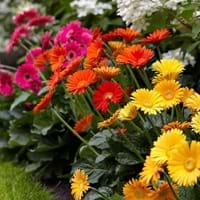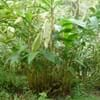Life Span
Perennial
Annual
Type
Tender Perennial
Tender Perennial
Origin
India
Southern Africa
Types
Green cardamom, Black cardamom
Single Flowers, Double or duplex
Habitat
Forests, Mountains
Grassland
USDA Hardiness Zone
10-12
9-11
AHS Heat Zone
Not Available
12-6
Sunset Zone
Not Available
H1, H2, 8, 9, 12, 13, 14, 15, 16, 17, 18, 19, 20, 21, 22, 23, 24
Habit
Clump-Forming
Cushion/Mound-forming
Minimum Width
Not Available
Flower Color
Light Yellow, Ivory
Pink
Flower Color Modifier
Bicolor
Bicolor
Fruit Color
Dark Red, Brown, Sienna
Not Available
Leaf Color in Spring
Green, Dark Green
Green
Leaf Color in Summer
Green, Dark Green
Green
Leaf Color in Fall
Green, Dark Green
Green
Leaf Color in Winter
Light Green
Light Green
Leaf Shape
Lanceolate
Spinach Type
Plant Season
Spring, Summer, Fall, Winter
Spring, Summer, Fall, Winter
Sunlight
Partial shade, Full Shade
Full Sun, Partial Sun
Type of Soil
Clay, Loam
Loam, Sand
The pH of Soil
Neutral
Acidic, Neutral
Soil Drainage
Well drained
Well drained
Bloom Time
Not Available
Indeterminate
Tolerances
Drought
Drought
Where to Plant?
Container, Ground
Container, Ground, Pot
How to Plant?
Seedlings
Seedlings, Stem Planting, Transplanting
Plant Maintenance
Medium
Medium
Watering Requirements
Average Water Needs, Do Not over Water
Do not water frequently, Water when soil is dry
In Summer
Lots of watering
Lots of watering
In Spring
Moderate
Moderate
In Winter
Average Water
Average Water
Soil pH
Neutral
Acidic, Neutral
Soil Type
Clay, Loam
Loam, Sand
Soil Drainage Capacity
Well drained
Well drained
Sun Exposure
Partial shade, Full Shade
Full Sun, Partial Sun
Pruning
Remove damaged leaves, Remove dead branches, Remove dead leaves
Remove dead leaves, Remove dead or diseased plant parts
Fertilizers
All-Purpose Liquid Fertilizer
All-Purpose Liquid Fertilizer
Pests and Diseases
Mosaic viruses, Nematodes, Red blotch, Thripes
Aphids, Gray mold, Leaf spot, Powdery mildew, Thripes, Whiteflies
Plant Tolerance
Drought
Drought
Flower Petal Number
Single
Single
Foliage Texture
Medium
Coarse
Foliage Sheen
Glossy
Matte
Attracts
Aphids, Insects
Bees
Allergy
Skin rash
Not Available
Aesthetic Uses
Not Used For Aesthetic Purpose
Bouquets, Showy Purposes
Beauty Benefits
Not Available
Not Available
Environmental Uses
Air purification
Air purification
Medicinal Uses
anti-cancer, anti-inflammatory, Antioxidants, Aphrodisiac, Cold, Diuretic, Fights Depression
Abandonment, Heart problems, Stomach pain
Part of Plant Used
Pods, Seeds
Flowers
Other Uses
Used for its medicinal properties, Used as a spice
Cosmetics, Decoration Purposes
Used As Indoor Plant
Yes
Yes
Used As Outdoor Plant
Yes
Yes
Garden Design
Edible, Herb / Vegetable, Mixed Border, Tropical
Bedding Plant, Container, Cutflower, Houseplant, Mixed Border, Tropical
Botanical Name
ELETTARIA cardamomum
GERBERA
Common Name
Cardamom
Barberton Daisy, Flori Line Midi Gerbera Daisy, Gerbera Daisy, Transvaal Daisy
In Hindi
इलायची
barbeton daisy
In German
Kardamom
Barbeton daisy
In French
Cardamome
Barbeton daisy
In Spanish
Cardamomo
barbeton margarita
In Greek
Κάρδαμο
barbeton μαργαρίτα
In Portuguese
Cardamomo
Barbeton daisy
In Polish
Kardamon
barbeton stokrotka
In Latin
Cardamom
Barberton primula
Phylum
Magnoliophyta
Not Available
Class
Liliopsida
Magnoliopsida
Order
Zingiberales
Asterales
Family
Zingiberaceae
Asteraceae
Clade
Angiosperms, Commelinids, Monocots
Angiosperms, Asterids, Eudicots
Tribe
Not Available
Mutisieae
Subfamily
Not Available
Mutisioideae
Number of Species
Not Available
Importance of Cardamom and Barberton Daisy
Want to have the most appropriate plant for your garden? You might want to know the importance of Cardamom and Barberton Daisy. Basically, these two plants vary in many aspects. Compare Cardamom and Barberton Daisy as they differ in many characteristics such as their life, care, benefits, facts, etc. Every gardener must at least have the slightest clue about the plants he wants to plant in his garden. Compare their benefits, which differ in many ways like facts and uses. The medicinal use of Cardamom is anti-cancer, anti-inflammatory, Antioxidants, Aphrodisiac, Cold, Diuretic and Fights Depression whereas of Barberton Daisy is Abandonment, Heart problems and Stomach pain. Cardamom has beauty benefits as follows: Not Available while Barberton Daisy has beauty benefits as follows: Not Available.
Compare Facts of Cardamom vs Barberton Daisy
How to choose the best garden plant for your garden depending upon its facts? Here garden plant comparison will help you to solve this query. Compare the facts of Cardamom vs Barberton Daisy and know which one to choose. As garden plants have benefits and other uses, allergy is also a major drawback of plants for some people. Allergic reactions of Cardamom are Skin rash whereas of Barberton Daisy have Not Available respectively. Having a fruit bearing plant in your garden can be a plus point of your garden. Cardamom has showy fruits and Barberton Daisy has no showy fruits. Also Cardamom is not flowering and Barberton Daisy is not flowering . You can compare Cardamom and Barberton Daisy facts and facts of other plants too.





